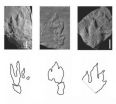(Press-News.org) JUPITER, FL, October 5, 2010 - Scripps Research Institute scientists have shown for the first time that the neurotransmitter serotonin uses a specialized signaling pathway to mediate biological functions that are distinct from the signaling pathways used by hallucinogenic substances. The new findings could have a profound effect on the development of new therapies for a number of disorders, including schizophrenia and depression.
The study was published in the October 6, 2010 issue of the Journal of Neuroscience.
Serotonin has tremendous influence over several brain functions, including the control of perception, cognition, sleep, appetite, pain, and mood and mediates these effects through interactions with receptors located throughout the central and peripheral nervous systems.
"Our study shows that while both serotonin and hallucinogens act at the serotonin 2A receptor, serotonin utilizes a very specific pathway and its actions are independent of those produced by hallucinogens," said Laura Bohn, an associate professor on the Florida campus of The Scripps Research Institute. "Future drug discovery efforts to identify lead compounds for treatment of depression may consider focusing upon those that only engage that pathway. This work may also lend insight into the mechanisms that underlie the hallucinations that occur in schizophrenia."
This may be particularly important, Bohn said, for the treatment of depression because traditional therapies, which focus on elevating serotonin levels, can sometimes produce serious side effects such as a serotonin syndrome. This syndrome is often accompanied by hallucinations, and is especially serious when antidepressant treatments such as selective serotonin reuptake inhibitors (SSRIs) are mixed with monoamine oxidase inhibitors (MAOIs).
The scientists' current study supports a long-standing hypothesis that hallucinations may arise from the metabolites formed from elevated serotonin levels. Since there is a difference in the way the two neurotransmitters signal, this may represent a means to preserve the effects of serotonin while preventing the adverse side effects caused by the metabolites.
Serotonin Versus Hallucinogens
The study, coauthored by Cullen Schmid, a graduate student in the lab, showed that serotonin signals through the serotonin 2A receptor by recruiting a regulatory protein called arrestin2, and that the actions of serotonin at the receptor are far different than those produced by hallucinogenic N-methyltryptamines, a class of naturally occurring substances found in several plants and in minute amounts in the human body and which includes the abused drug, DMT. The study found that the N-methyltryptamines activate the serotonin 2A receptor independently of arrestin2.
Both serotonin and the N-methyltryptamines produce what is known as a head twitch response in animal models, which indicates that the serotonin 2A receptor has been activated. Any interruption in the exclusive serotonin pathway prevents that behavioral response to serotonin, but has no effect on N-methyltryptamine-induced head twitches, indicating a distinct divergence in the signaling pathways utilized by these two neurotransmitters.
"Despite the fact that they activate the same receptor, serotonin leads to the assembly of a number of proteins associated with the receptor that the metabolites of serotonin do not produce," Bohn said. "But whether the lack of this complex formation is why compounds like DMT lead to hallucinations is not clear."
Bohn continues to investigate these and other questions.
INFORMATION:
In addition to Bohn, the study, "Serotonin, But Not N-Methyltryptamines, Activates the Serotonin 2A Receptor via an Arrestin2/Src/Akt Signaling Complex in Vivo," was authored by Cullen L. Schmid of The Ohio State University Neuroscience Graduate Studies Program and Scripps Research.
The work was supported by the National Institute on Drug Abuse of the National Institutes of Health.
About The Scripps Research Institute
The Scripps Research Institute is one of the world's largest independent, non-profit biomedical research organizations, at the forefront of basic biomedical science that seeks to comprehend the most fundamental processes of life. Scripps Research is internationally recognized for its discoveries in immunology, molecular and cellular biology, chemistry, neurosciences, autoimmune, cardiovascular, and infectious diseases, and synthetic vaccine development. An institution that evolved from the Scripps Metabolic Clinic founded by philanthropist Ellen Browning Scripps in 1924, Scripps Research currently employs approximately 3,000 scientists, postdoctoral fellows, scientific and other technicians, doctoral degree graduate students, and administrative and technical support personnel. Headquartered in La Jolla, California, the institute also includes Scripps Florida, whose researchers focus on basic biomedical science, drug discovery, and technology development. Scripps Florida is located in Jupiter, Florida. For more information, see www.scripps.edu
Chemists at Vanderbilt University have created a new class of liquid crystals with unique electrical properties that could improve the performance of digital displays used on everything from digital watches to flat panel televisions.
The achievement, which is the result of more than five years of effort, is described by Professor of Chemistry Piotr Kaszynski and graduate student Bryan Ringstrand in a pair of articles published online on Sept. 24 and Sept. 28 in the Journal of Materials Chemistry.
"We have created liquid crystals with an unprecedented electric ...
After a decade of joint work involving 2,700 researchers from 80 countries, the world's scientists – as well as the general public – can now access the Census of Marine Life, which provides the first in-depth look at the more than 120,000 diverse species which inhabit our oceans.
The Census of Marine Life initiative, started in 2000, is the result of one of the largest scientific collaborations ever conducted , the result of more than 540 expeditions and 9,000 days at sea, plus more than 2,600 academic papers published during that period.
The just-released census paints ...
Measuring a fuel cell's overall performance is relatively easy, but measuring its components individually as they work together is a challenge. That's because one of the best experimental techniques for investigating the details of an electrochemical device while it's operating is x-ray photoelectron spectroscopy (XPS). Traditional XPS works only in a vacuum, while fuel cells need gases under pressure to function.
Now a team of scientists from the University of Maryland, the U.S. Department of Energy's Sandia National Laboratories, and DOE's Lawrence Berkeley National ...
New neuroscience research by life scientists from UCLA and Australia may potentially help people who have lost their ability to remember due to brain injury or disease.
By examining how we learn and store memories, these scientists have shown that the way the brain first captures and encodes a situation or event is quite different from how it processes subsequent similar events.
The study is published in the Sept. 29 edition of the online journal PLoS ONE, a publication of the Public Library of Science.
Memories are formed in the part of the brain known as the ...
The following highlights summarize research papers that have been recently published in Geophysical Research Letters (GRL), Journal of Geophysical Research-Atmospheres (JGR-D), or Water Resources Research (WRR).
1. Antarctic sea ice increase not linked to ozone hole
While sea ice extent has declined dramatically in the Arctic in recent years, it has increased slightly in the Antarctic. Some scientists have suggested that increased Antarctic sea ice extent can be explained by the ozone hole over Antarctica. Previous simulations have indicated that the ozone hole induces ...
The oldest evidence of the dinosaur lineage—fossilized tracks—is described this week in Proceedings of the Royal Society B. Just one or two million years after the massive Permian-Triassic extinction, an animal smaller than a house cat walked across fine mud in what is now Poland. This fossilized trackway places the very closest relatives of dinosaurs on Earth about 250 million years ago—5 to 9 million years earlier than previously described fossilized skeletal material has indicated. The paper also described the 246-million-year-old Sphingopus footprints, the oldest evidence ...
CHAMPAIGN, Ill. – When the economy sours, small firms seeking credit tend to face higher costs of financing, leading them to reinvest their profits before they pay off creditors, according to research published by a University of Illinois finance expert.
Small firms, especially those considered financially constrained as a result of their size, low dividend payment or lack of bond rating, often become bogged down in debt because they "get hooked on cheap money, when they can find it" says U. of I. finance professor Murillo Campello.
"Since small firms are usually financially ...
AMES, Iowa - Some fisheries in the United States are poised to undergo major changes in the regulations used to protect fish stocks, and Iowa State University researchers have estimated that the new system will be an economic boon to the fishing industry.
Quinn Weninger and Rajesh Singh, both associate professors in economics, estimated harvesting costs under the old system and compared that to the newly proposed fishing regulations that lift many restrictions that cause inefficiency while still limiting amounts to be harvested.
Their analysis focused on the Pacific Groundfish ...
The pace and extent of Marcellus Shale development across Pennsylvania can be "seen" in animated maps produced by the Penn State Marcellus Center for Outreach and Research.
Based on data from the Pennsylvania Department of Environmental Protection, the animations (http://www.marcellus.psu.edu/resources/maps.php) show both the number of drilling permits issued for the Marcellus Shale target and the number of wells drilled by year from 2007 through August 2010. Although permits were issued prior to 2007, information on those permits did not include latitude and longitude.
"These ...
Sensation seeking—the urge to do exciting things—has been linked to dopamine, a chemical that carries messages in your brain. For a new study published in Psychological Science, a journal of the Association for Psychological Science, scientists analyzed genes in the dopamine system and found a group of mutations that help predict whether someone is inclined toward sensation seeking.
Sensation seeking has been linked to a range of behavior disorders, such as drug addiction. It isn't all bad, though. "Not everyone who's high on sensation seeking becomes a drug addict. They ...




